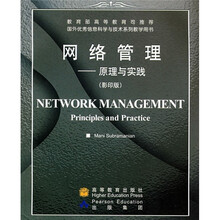PART1 Background
Chapter1 Data Communications and Network Management Overview
1.1 Analogy of Telephone Network Management
1.2 Data (Computer) and Telecommunication Network
1.3 Distributed Computing Environments
1.4 TCP/IP——Based Networks: The Internet and intranets
1.5 Communications Protocols and Standards
1.5.1 Communication Architectures
1.5.2 Protocol Layers and Services
1.6 Case Histories of Networking and Management
1.6.1 Case History l: The Importance of Topology ("The Case of the Footprint")
1.6.2 Case History 2: Filtering Does Not Reduce Load on Node
1.6.3 Some Common Network Problems
1.7 Challenges of information Technology Managers
1.8 Network Management: Goals, Organization, and Functions
1.8.1 Goal of Network Management
1.8.2 Network Provisioning
1.8.3 Network Operations and the DOC
1.8.4 Network Installation and Maintenance
1.9 Network and System Management
1.10 Network Management System Platform
1.11 Current Status and Future of Network Management
Chapter 2 Review of Computer Network T6chnology
2.1 Network Topology
2.2 Local Area Networks
2.2.1 Ethernet
2.2.2 Fast Ethernet
2.2.3 Gigabit Ethernet
2.2.4 Full-Duplex Ethernets
2.2.5 Switched Ethernet
2.2.6 Virtual LANs
2.2.7 Token Ring
2.2.8 Fiber Distributed Data interface
2.3 Network Node Components
2.3.1 Hubs
2.3.2 Bridges
2.3.3 Remote Bridges
2.3.4 Transparent Bridges
2.3.5 Source Routing Bridges
2.3.6 Routers
2.3.7 Gateways and Protocol Converters
2.3.8 Multiprotocol Routers and Tunneling
2.3.9 Half-Bridge Configuration of Routers
2.3.10 Switches
2.4 Wide Area Networks
2.5 Transmission Technology
2.5.1 Wired Transmission
2.5.2 Wireless Transmission Media
2.5.3 Transmission Modes
2.6 Integrated Services: ISDN, Frame Relay, and Broadband
PART 2 SNAP, Broadband,andTANManagement
Chapter 3 BasicFoundations: Standards, Models. and Language
3.1 Network Management Standards
3.2 Network Management Model
3.3 Organization Model
3.4 Information Model
3.4.1 Management information Trees 11 1
3.4.2 Managed Object Perspectives 112
3.5 Communication Model
3.6 Abstract Syntax Notation One: ASN.1
3.6.1 Terminology, Symbols, and Conventions
3.6.2 Objects and Data Types
3.6.3 Object Names
3.6.4 An Example of ASN.1 from ISO 8824
3.7 Encoding Structure
3.8 Macros
3.9 Functional Model
Chapter4 SNMPvl Network Management:Organization andInformation Models
4.1 Managed Network:Case Histories and Examples
4.2 The History of SNMP Management
4.3 Internet Organizations and Standards
4.3.1 Organizations
4.3.2 Internet Documents
4.4 The SNMP Model
4.5 The Organization Model
4.6 System Overview
4.7 The Information Model
4.7.1 Introduction
4.7.2 The Structure of Management Information
4.7.3 Managed Objects
4.7.4 Management Information Base
Chapter5 SNMPvl Network Management:Communication andFunctional Models
5.1 The SNMP Communication Model
5.1.1 The SNMP Architecture
5.1.2 The Administrative Model
5.1.3 SNMP Protocol Specifications
5.1.4 SNMP Operations
5.1.5 The SNMP MIB Group
5.2 Functional Model
Chapter6 SNMP Management:SNMPv2
6.1 Major Changes in SNMPv2
6.2 SNMPv2 System Architecture
6.3 SNMPv2 Structure of Management Information
6.3.1 SMI Definitions for SNMPv2
6.3.2 Information Modules
6.3.3 SNMP Keywords
6.3.4 Module Definitions
CHAPTER7 SNMPMANAGEMENT:SNMPv3
Chapter8 SNMPManagement:RMON
Chapter9 BroadbandNetworkManagement:ATMNetworks
Chapter10 BroadbandNetworkManagement
Chapter11 TelecommunicationsManagementNetwork
PART3 ManagementTools,Systems,andApplications
Chapter12 NetworkManagementToolsandsystems
Chapter13 NetworManagementApplications
Chapter14 Web-BasedManagement
AppendixA OSINetworkandsystemManagement
AppendixB ProjectSuggestions
SelectedBibliography
Index
MANI SUBRAMANIAN is a professor at Georgia Institute of Technology,where he teaches a Network Manage-ment course based on his years of industry experience。 He has led Research and development at several networking corporations and has practical knowledge of networking and netowrk management。 In1989,he has elected Tech-nical Kirector of the OSI Network Management Forum and was responsible for the first release of OSI NM specificatiions。Dr.Subramanian received his Ph.D.from Purdue University。

 缺书网
缺书网 扫码进群
扫码进群





